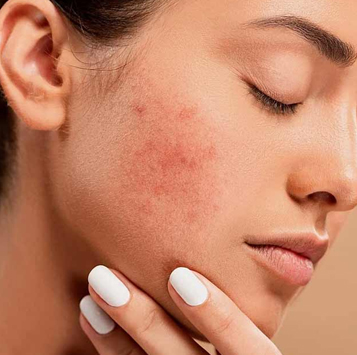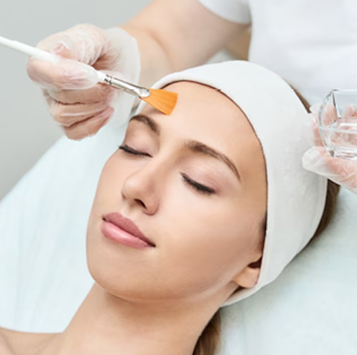Best Acne Treatments in Ghatkopar

Acne Treatment
Acne is a common skin condition that affects many people, and there are various treatments available to help manage and reduce the symptoms. Here are some options:
1. Topical medications: There are many topical medications available over-the-counter or by prescription that can help treat acne. These include benzoyl peroxide, salicylic acid, and retinoids. These medications work by killing bacteria, reducing inflammation, and unclogging pores.
2. Oral medications: In more severe cases of acne, your doctor may prescribe oral medications, such as antibiotics, birth control pills, or isotretinoin. These medications work by reducing inflammation and killing bacteria.
3. Light therapy: Light therapy is a treatment that uses specific wavelengths of light to kill bacteria and reduce inflammation in the skin.
4. Chemical peels: Chemical peels use a chemical solution to remove the outer layer of skin, which can help reduce the appearance of acne scars and prevent new acne from forming.
5. Extraction: A dermatologist can perform extractions, which involve removing blackheads and whiteheads from the skin using special tools.
6. Lifestyle changes: Making changes to your diet, stress management, and skincare routine can also help reduce the symptoms of acne.

Peels
Chemical peels are a cosmetic treatment that involve applying a chemical solution to the skin to exfoliate the outer layer of dead skin cells, revealing smoother, brighter skin underneath. There are three main types of chemical peels:
1. Superficial peels: These use a mild acid, such as alpha-hydroxy acid (AHA), to exfoliate the top layer of skin. They are often used to improve the texture and appearance of skin that has been damaged by sun exposure, acne, or aging.
2. Medium peels: These use a stronger acid, such as trichloroacetic acid (TCA), to penetrate deeper into the skin and remove damaged skin cells. They can help reduce the appearance of fine lines, wrinkles, and age spots, as well as improve skin texture.
3. Deep peels: These use a very strong acid, such as phenol, to penetrate deep into the skin and remove damaged skin cells. They are used to treat more severe skin conditions, such as deep wrinkles, scars, and hyperpigmentation.
Chemical peels can be done on the face, neck, chest, or hands, and the treatment takes about 15-30 minutes, depending on the type of peel. After the treatment, the skin may be red and sensitive, and it will peel and flake for several days. It’s important to avoid sun exposure and wear sunscreen after a chemical peel to protect the newly revealed skin. It’s also important to consult with a dermatologist to determine the best type of peel for your skin type and concerns.

Acne Scar Revision
Acne scars can be a frustrating reminder of past breakouts. However, there are several options available to help reduce the appearance of acne scars. Here are some common acne scar revision treatments:
1. Chemical Peels: As mentioned before, chemical peels can help exfoliate the outer layers of the skin, revealing smoother skin underneath. This can reduce the appearance of acne scars over time.
2. Microdermabrasion: This treatment uses a special device to exfoliate the outer layers of the skin, which can help reduce the appearance of acne scars. Microdermabrasion can be done at a dermatologist’s office or at home using a special device.
3. Dermal Fillers: Fillers such as hyaluronic acid, collagen, or fat can be injected into the skin to fill in depressed acne scars and create a smoother surface.
4. Microneedling: This treatment uses a device that creates small punctures in the skin to stimulate collagen production and improve the texture of the skin. Over time, this can reduce the appearance of acne scars.
5. Laser Resurfacing: Laser resurfacing uses a laser to remove the outer layers of skin, which can reduce the appearance of acne scars. This treatment can be done

Subcision
Subcision is a surgical procedure that is commonly used to treat deep, tethered acne scars. It involves using a special needle or blade to break up the fibrous bands of tissue that are causing the scar to be tethered to the underlying skin. By releasing these bands, the scar is allowed to elevate, which can improve its appearance.
During the subcision procedure, the area to be treated is first numbed with a local anesthetic. Then, a needle or blade is inserted under the skin, and the fibrous bands are cut or released using a back-and-forth motion. This can cause some bleeding, which helps to create a space between the scar and the underlying tissue.
After the subcision procedure, a compression dressing may be applied to the area to help reduce swelling and promote healing. It’s important to avoid any strenuous activity for a few days after the procedure and to avoid exposing the area to sunlight until it has fully healed.
Subcision can be an effective treatment for deep, tethered acne scars. However, it is not suitable for all types of scars and may not be effective in all cases. It’s important to consult with a dermatologist to determine if subcision is the right treatment for your specific case of acne scars.

TCA Cross
TCA cross is a chemical peel technique that is commonly used to treat deep, narrow acne scars. TCA stands for trichloroacetic acid, which is a chemical that is applied to the skin to exfoliate the outer layers and promote collagen production. TCA cross involves applying a high concentration of TCA to the base of the acne scar using a small applicator or toothpick.
The TCA cross technique works by creating controlled damage to the base of the scar, which triggers the body’s natural healing response. This can help to stimulate collagen production and fill in the depression of the scar. Over time, the scar may become less noticeable and the skin’s texture may improve.
After the TCA cross procedure, the treated area may be red and scab over for a few days. It’s important to avoid picking at the scab, as this can increase the risk of scarring. Sun exposure should also be avoided until the skin has fully healed.
TCA cross can be an effective treatment for deep, narrow acne scars. However, it is not suitable for all types of scars and may not be effective in all cases. It’s important to consult with a dermatologist to determine if TCA cross is the right treatment for your specific case of acne scars.





